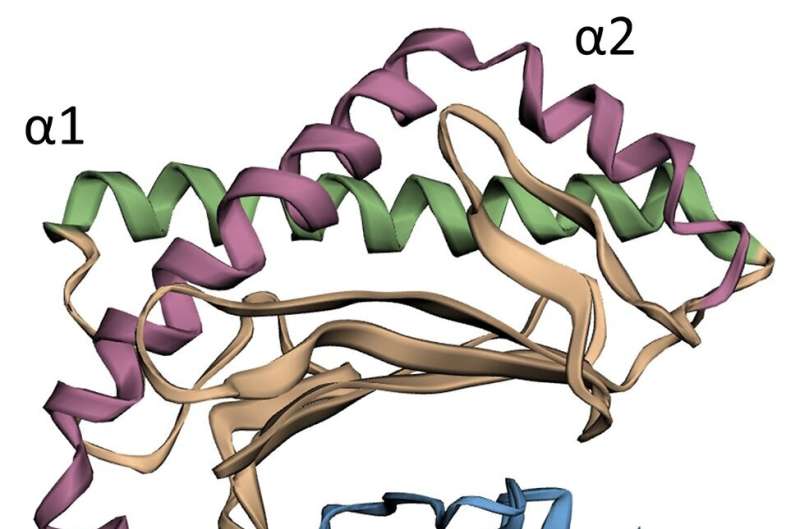

Scientists have found that the naked mole-rat—an underground rodent that lives up to 40 years—has lost a number of CD1 functional genes. The CD1 gene family in mammals is responsible for protein synthesis that protects the body against infectious diseases. The findings indicate that the naked mole-rat’s immune system has significantly realigned and is using other—CD1-independent—molecular mechanisms.
The results of the research are published in the Biology Direct.
Some epithelial and immune system cells (macrophages, B-lymphocytes, dendritic cells) of mammals, birds and reptiles carry CD1 proteins on their surface that have structural similarities to major histocompatibility complex (MHC) proteins that play an important role in the development of immunity.
If a foreign object appears in a body—bacteria, for example—these molecules help alert a different type of immune cells called T-lymphocytes that contribute to the destruction of the infected cells and thus prevent the infection from spreading. This happens because just like flags, the CD1 proteins expose cells, bacterial lipids and their derivatives above their surface, by which the pathogen can be easily identified.
The constitution and the number of CD1 genes differ greatly in various animals. For example, mice have two, rats have one and guinea pigs have as many as nine. Since the majority of preclinical drug tests are carried out on these specific animals, the search and identification of their CD1 functional molecules are especially critical for the correct interpretation of fundamental and applied research results. However, there is no known mammalian species that has entirely lost its CD1 proteins.
Scientists at the Baltic Federal University of Immanuel Kant (Kaliningrad), the Institute For Molecular Biology RAS (Moscow), Institute of Molecular Cell Biology SB RAS (Novosibirsk), Moscow State University (Moscow), and Karolinska Institute (Sweden) and colleagues have described the evolution of CD1 genes in rodents.
For this purpose, the scientists have conducted a bioinformatics analysis of sequences responsible for CD1 protein synthesis in the genomes of 18 different species of rodents and have reconstructed the related protein structures. The authors have found for the first time that the naked mole-rat (Heterocephalus glaber) has lost a part of its working (functional) CD1 genes.
This animal belongs to hystricomorphs and is characterized by an unusually long lifespan for rodents—up to 40 years. Therefore, naked mole-rats are important for research of aging mechanisms. The absence of CD1 proteins revealed by the authors points out to yet another unusual trait of this rodent—unconventional mechanisms of the immune system.
“Recent studies of the naked mole-rat’s immune system have shown the absence of natural killer T cells that take part in the removal of the virus- and bacteria-infected cells, as well as tumor cells. Since the presence of the functionally active CD1 gene is necessary for the development of Natural Killer T cells, we have suggested that the naked mole-rat’s immune response occurs differently, independent of Natural Killer T cells,” explains Alexey Zamaraev, participant on the project, candidate of biological sciences, and research associate at the IMB and mechanisms of apoptosis research laboratory at Moscow State University.
“These facts highlight the uniqueness of the naked mole-rat’s immune system. It is probable that other immune cells compensate for the loss of some CD1 proteins and natural killer T cells in naked mole-rats—the myeloid cells of the immune system and other types of well-developed T lymphocytes of these animals,” continues Zamaraev.
The analysis has also shown that the CD1 proteins that differ widely in structure are a characteristic of the suborder Myomorpha representatives. Their relatives from the Sciuromorpha, Castorimorpha and Hystricomorpha suborders have more conserved—less differing—proteins. This emphasizes that these particular suborders are more evolutionarily ancient.
“In the future, we are planning to examine another type of molecule with the same as the CD1 proteins function—MR1 proteins, which introduce (or show) riboflavin’s metabolites or other bacterial antigens to specific T-lymphocytes,” says Constantin Gunbin, another participant on the project, candidate of biological sciences, Senior Researcher at the Centre for Genomic Research at BFU.
“We hope that the data obtained will allow us to understand not only the fundamental features of the immune system of different animals, but to identify patterns for targeted activation of CD1-specific T-cells and for triggering of the immune response to different pathogens,” adds Gunbin.
More information:
Konstantin V. Gunbin et al, Features of the CD1 gene family in rodents and the uniqueness of the immune system of naked mole-rat, Biology Direct (2024). DOI: 10.1186/s13062-024-00503-z
Provided by
Scientific Project Lomonosov
Citation:
Naked mole-rat found to have lost infection-resistant proteins (2024, September 25)
retrieved 25 September 2024
from https://phys.org/news/2024-09-naked-mole-rat-lost-infection.html
This document is subject to copyright. Apart from any fair dealing for the purpose of private study or research, no
part may be reproduced without the written permission. The content is provided for information purposes only.